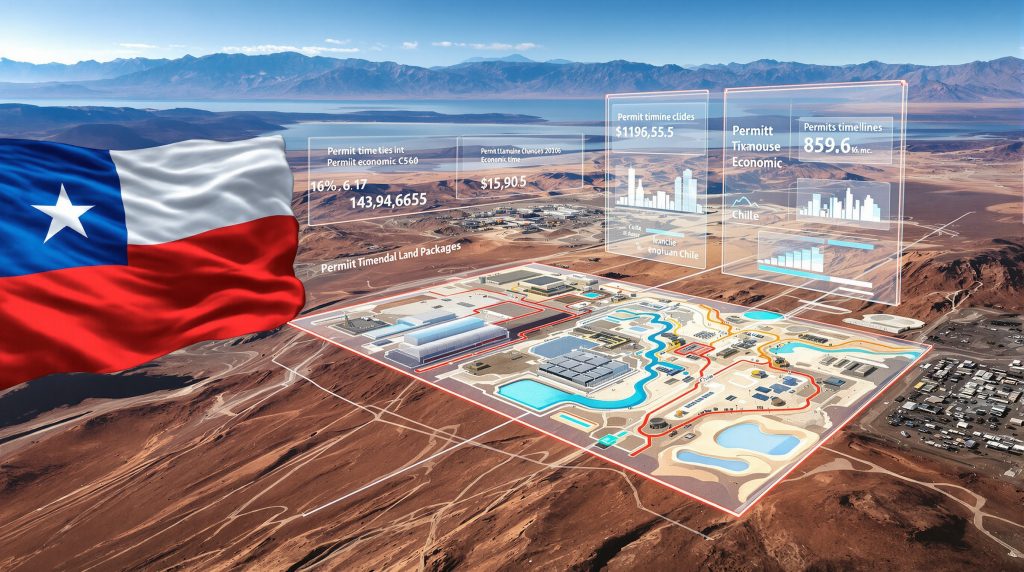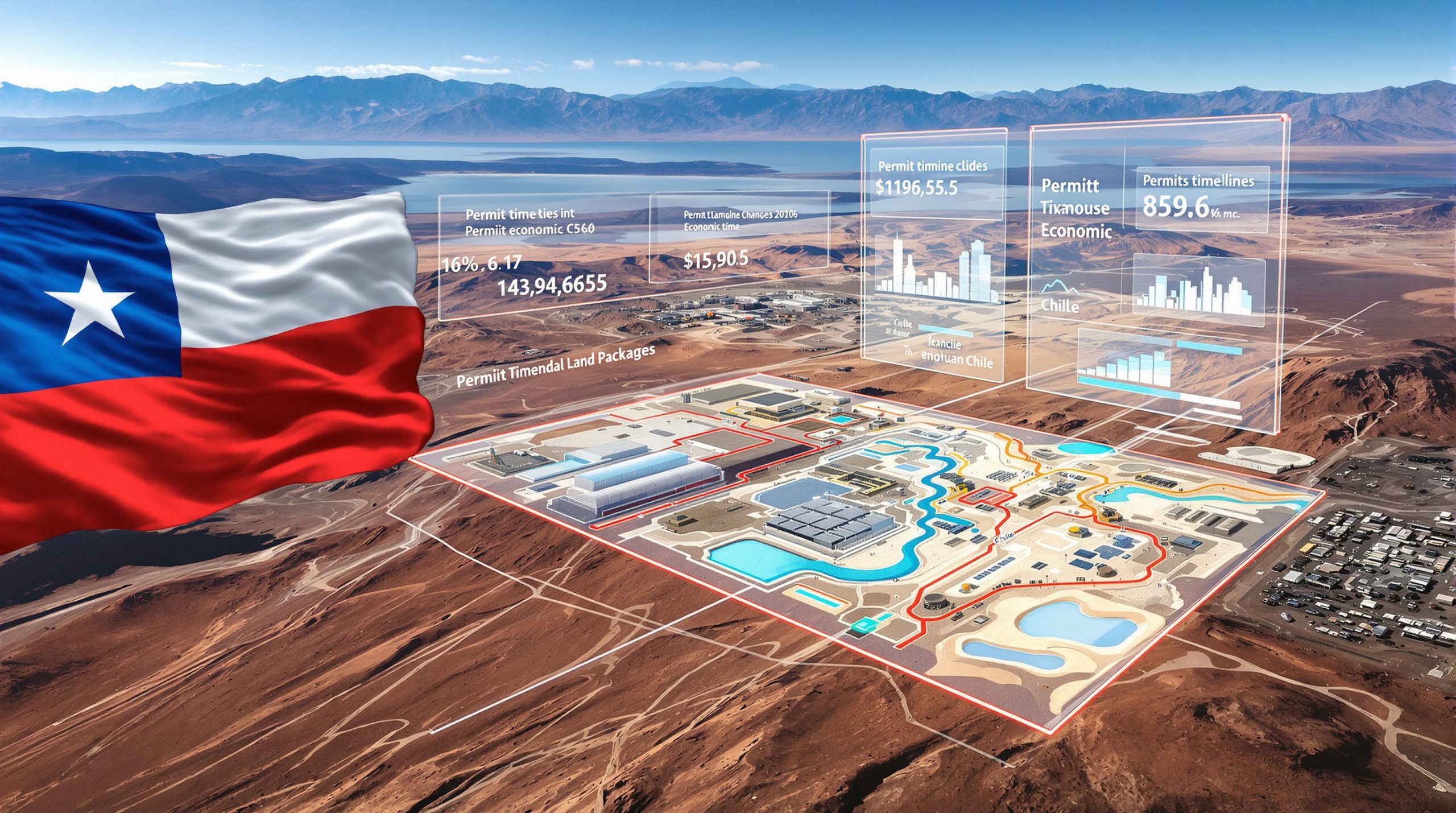Why Are Strategic Land Packages Critical for Mining Projects in Chile?
Chile's position as a global mining powerhouse depends heavily on strategic land control. Companies operating in this resource-rich nation understand that securing extensive surface rights packages provides crucial operational advantages beyond mere exploration potential. These packages serve as foundational assets that determine project viability, permitting timelines, and long-term operational flexibility.
Strategic land packages in Chile typically include:
- Surface rights across large contiguous areas
- Water access rights (increasingly valuable in arid regions)
- Infrastructure corridors for transportation and utilities
- Buffer zones to prevent encroachment from competing interests
- Environmental management areas for sustainability compliance
Without comprehensive land control, mining projects face significant obstacles in mining permitting basics, development timelines, and operational efficiency, regardless of mineral resource quality.
How Does Chile's Regulatory Framework Impact Land Package Acquisition?
Chile's mining regulations create a unique environment where surface rights and mineral rights operate under separate legal frameworks. This dual system necessitates strategic approaches to land acquisition.
The Critical Surface Rights Requirement
Unlike some jurisdictions where mineral rights automatically grant surface access, Chilean regulations mandate separate surface rights ownership or agreements before entering the permit process for:
- Exploration activities beyond basic surveying
- Construction of access roads and infrastructure
- Development of processing facilities
- Water management systems
- Environmental monitoring stations
This regulatory structure creates a sequential dependency where surface rights acquisition becomes a prerequisite for project advancement rather than a parallel activity.
Water Rights Considerations in Land Packages
In Chile's northern regions, where most major mining operations are concentrated, water access represents a critical component of strategic land packages in Chile. The acquisition of water rights provides:
- Operational security for processing activities
- Reduced dependency on third-party suppliers
- Lower long-term operational costs
- Simplified environmental compliance
- Protection against future water scarcity issues
Companies that secure comprehensive water rights as part of their land packages gain significant competitive advantages in project economics and development timelines.
What Makes a Land Package Truly "Strategic" in the Chilean Context?
Not all land acquisitions qualify as strategic packages. The distinction lies in how the land position enhances project value beyond simple resource access.
Geographic Positioning and Regional Control
Strategic land packages typically occupy key positions within established mining districts or emerging exploration regions. The most valuable packages offer:
- Control over multiple prospective geological targets
- Proximity to existing infrastructure (power, roads, ports)
- Buffer zones preventing competitive encroachment
- Expansion potential for future operations
- Regional consolidation opportunities
The Maricunga and Atacama regions demonstrate how strategic land control has enabled major mining companies to establish dominant positions through systematic acquisition of key surface rights.
Infrastructure Development Potential
The ability to design and implement optimal infrastructure represents a core value driver for strategic land packages. Companies with extensive surface rights can:
- Design efficient transportation corridors
- Optimize processing facility locations
- Implement renewable energy generation
- Develop water management systems
- Create buffer zones for environmental compliance
This infrastructure flexibility translates directly into improved project economics and accelerated development timelines through modern mine planning.
What Are the Economic Implications of Strategic Land Package Acquisition?
The financial considerations surrounding strategic land packages extend far beyond the initial acquisition costs. These investments fundamentally reshape project economics.
Cost Structure Transformation
Strategic land packages can dramatically alter project cost structures through:
- Elimination of ongoing access fees to third-party landowners
- Reduction in water procurement expenses
- Optimization of transportation routes and costs
- Simplified permitting processes with fewer stakeholders
- Revenue generation from land access agreements with neighboring operations
Case studies from the Atacama region demonstrate that companies with comprehensive land control typically achieve 15-20% lower operational costs compared to those reliant on fragmented land access agreements.
Valuation Impact and Investment Attractiveness
The market consistently assigns premium valuations to mining projects with secured strategic land packages. This valuation premium reflects:
- Reduced permitting risks
- Accelerated development timelines
- Enhanced operational flexibility
- Improved long-term cost structures
- Strategic optionality for partnerships or acquisitions
Institutional investors increasingly evaluate land package quality as a core component of investment decisions, particularly for projects in competitive mining districts.
How Do Recent Strategic Land Acquisitions in Chile Demonstrate Best Practices?
Recent transactions provide valuable insights into effective approaches to strategic land package assembly in Chile's competitive mining landscape.
ATEX Resources' Valeriano Project Land Consolidation
ATEX Resources' acquisition of a 14,550-hectare surface rights package surrounding its Valeriano copper project exemplifies modern strategic land assembly. This $21 million USD transaction delivered multiple strategic advantages:
- Complete surface access across a 25km by 5-10km corridor
- Valuable water rights reducing operational costs
- Elimination of access fees previously paid to landowners
- Revenue generation from existing land access agreements
- Strategic positioning adjacent to major mining operations
The acquisition transformed Valeriano's development pathway by eliminating key permitting risks and creating new strategic options for infrastructure development and potential partnerships with neighboring major miners.
Los Andes Copper's Vizcachitas Expansion Strategy
Los Andes Copper demonstrated a different approach to strategic land assembly by systematically expanding its holdings around the Vizcachitas copper-molybdenum project. Their acquisition of additional exploration claims totaling 25 km² increased total land holdings to 474.4 km², enhancing:
- Geological prospectivity across multiple target zones
- Infrastructure development flexibility
- Regional consolidation potential
- Environmental management options
- Strategic positioning within Chile's central copper belt
This methodical expansion approach illustrates how incremental land acquisitions can collectively create a strategic position within established mining districts.
What Role Do Strategic Land Packages Play in Project De-risking?
Beyond their operational and economic benefits, strategic land packages serve as powerful de-risking mechanisms for mining projects in Chile.
Permitting Acceleration and Certainty
The permitting process represents a significant risk factor for mining projects globally. In Chile, strategic land packages directly mitigate this risk through:
- Simplified stakeholder engagement with fewer landowners
- Streamlined environmental assessment processes
- Reduced community impact complexities
- Greater flexibility in facility siting and design
- Elimination of third-party access negotiations
Projects with comprehensive land control typically achieve permitting milestones 30-40% faster than those with fragmented land access arrangements.
Operational Flexibility and Adaptation Capacity
Mining projects inevitably encounter challenges requiring operational adaptations. Strategic land packages provide crucial flexibility to:
- Modify infrastructure layouts as needed
- Adjust processing methodologies
- Implement additional environmental controls
- Accommodate expansion requirements
- Respond to changing regulatory requirements
This adaptation capacity represents a significant risk reduction factor that enhances project resilience throughout its lifecycle.
How Do Strategic Land Packages Enable Partnership and Consolidation Opportunities?
Companies that secure strategic land positions gain significant advantages in regional consolidation and partnership scenarios.
Creating Leverage for Major Miner Partnerships
Junior mining companies with strategic land packages frequently attract partnership interest from major mining companies. These partnerships typically emerge when:
- The land package controls access to adjacent resources
- Infrastructure synergies exist between neighboring projects
- Regional consolidation would optimize development efficiency
- Water or power resources can be shared
- Processing facilities could serve multiple operations
The negotiating leverage provided by strategic land control often translates into premium valuations in partnership or acquisition scenarios, furthering mining industry consolidation.
Regional Consolidation Platforms
Strategic land packages frequently serve as platforms for regional consolidation, particularly in established mining districts. Companies controlling key land positions can:
- Acquire adjacent exploration properties at advantageous terms
- Negotiate favorable joint venture arrangements
- Implement district-scale infrastructure solutions
- Optimize resource development across multiple projects
- Create comprehensive environmental management systems
This consolidation potential represents a significant value driver beyond the immediate project economics.
What Future Trends Will Impact Strategic Land Package Acquisition in Chile?
Evolving regulatory, environmental, and community factors will reshape strategic land acquisition strategies in Chile's mining sector.
Water Scarcity and Rights Valuation
Chile's northern regions face increasing water scarcity challenges, fundamentally altering the valuation of water rights within strategic land packages. Future trends include:
- Premium valuations for packages with secured water rights
- Increased regulatory scrutiny of water usage
- Growing importance of water recycling infrastructure
- Rising costs for third-party water procurement
- Potential for water rights trading markets
Companies that secure comprehensive water rights as part of their land packages will gain significant competitive advantages as scarcity increases.
Community Engagement and Social License Evolution
Social license considerations are becoming increasingly central to strategic land package assembly. Future successful approaches will incorporate:
- Early community engagement in land acquisition planning
- Benefit-sharing arrangements with local stakeholders
- Co-development of infrastructure with community value
- Transparent communication about land use intentions
- Long-term community development commitments
Land packages assembled with strong community support will achieve accelerated permitting timelines and reduced operational risks compared to those facing community opposition.
How Can Companies Optimize Their Strategic Land Package Investments?
Maximizing the value of strategic land packages requires systematic approaches beyond simple acquisition.
Comprehensive Land Package Assessment Methodologies
Leading companies employ sophisticated assessment methodologies to evaluate potential land package acquisitions, including:
- Multi-factor scoring systems for land package attributes
- Quantitative modeling of permitting timeline impacts
- Scenario analysis for infrastructure optimization
- Valuation of water rights under various scarcity scenarios
- Strategic positioning analysis relative to competitors
These assessment frameworks enable data-driven acquisition decisions that maximize return on investment for land package expenditures.
Phased Acquisition Strategies
Rather than pursuing single large acquisitions, many companies implement phased approaches to strategic land assembly:
- Initial acquisition of critical access corridors
- Systematic expansion around key infrastructure nodes
- Targeted acquisition of water rights
- Strategic positioning for regional consolidation
- Opportunistic acquisition during market downturns
This phased approach optimizes capital deployment while systematically building comprehensive land control.
What Questions Should Investors Ask About Strategic Land Packages?
Investors evaluating mining projects in Chile should assess land package quality as a core component of investment decisions.
Critical Due Diligence Questions
Effective due diligence regarding strategic land packages should address:
- Does the company control 100% of surface rights required for all project components?
- What water rights are included in the land package and are they sufficient for planned operations?
- How does the land package position the company relative to neighboring projects and potential partnerships?
- What infrastructure optimization opportunities does the land package enable?
- How has the company engaged with local communities regarding land use plans?
- What additional value-creation opportunities exist beyond the immediate project?
- How does the land package mitigate specific permitting or operational risks?
- What is the company's strategy for maximizing the value of its land position?
These questions help investors distinguish between companies with truly strategic land positions and those with basic operational footprints.
Red Flags in Land Package Claims
Investors should be alert to potential issues in company claims regarding strategic land packages:
- Vague descriptions of surface rights status
- Unclear water rights positions
- Excessive focus on mineral rights without addressing surface access
- Limited discussion of permitting implications
- Absence of community engagement strategies
- Unrealistic timelines for projects with incomplete land control
- Failure to quantify economic benefits of land package
These warning signs often indicate potential challenges that could impact project development timelines and economics.
How Do Strategic Land Packages Compare Across Global Mining Jurisdictions?
Chile's approach to land rights creates unique considerations compared to other major mining jurisdictions.
Comparative Analysis of Land Rights Frameworks
Strategic land package assembly varies significantly across global mining regions:
| Jurisdiction | Surface/Mineral Rights Relationship | Water Rights Structure | Key Strategic Considerations |
|---|---|---|---|
| Chile | Separate systems requiring distinct acquisition | Water rights separately acquired and transferable | Surface rights critical for permitting; water rights increasingly valuable |
| Australia | Crown land system with mineral rights typically held by state | Water rights typically separate from land | Native title considerations; state agreements often required |
| Canada | Provincial variations; surface and mineral rights often separated | Water rights typically regulated by provinces | First Nations consultation requirements; provincial variations |
| United States | Split estate common with separate surface/mineral ownership | Water rights vary by state; prior appropriation common | Complex checkerboard ownership patterns; federal land considerations |
| Peru | Surface rights separate from mineral concessions | Water rights administered by national authority | Community consultation requirements; surface rights negotiations |
This comparative framework highlights Chile's unique emphasis on surface rights control as a prerequisite for project advancement.
Global Best Practices Applicable to Chile
Despite jurisdictional differences, certain global best practices in strategic land assembly apply effectively in Chile:
- Early engagement with communities and stakeholders
- Comprehensive mapping of all rights holders
- Strategic phasing of acquisitions to optimize capital deployment
- Integration of infrastructure planning with land acquisition strategy
- Transparent communication about development intentions
- Consideration of regional consolidation opportunities
- Long-term view of land package value beyond immediate project needs
Companies that apply these global best practices while addressing Chile's specific regulatory requirements achieve superior outcomes in strategic land assembly.
What Are the Most Common Mistakes in Strategic Land Package Assembly?
Learning from historical challenges can help companies avoid costly errors in land package assembly.
Timing and Sequencing Errors
Many companies encounter difficulties due to suboptimal timing and sequencing in land acquisition:
- Delaying surface rights acquisition until after resource definition
- Announcing project plans before securing key surface rights
- Underestimating negotiation timeframes with multiple landowners
- Failing to secure water rights early in the development process
- Missing opportunities for strategic acquisitions during market downturns
These timing errors frequently result in inflated acquisition costs, extended development timelines, and suboptimal land package configurations.
Scope and Configuration Mistakes
The physical configuration of land packages often contains critical flaws that limit their strategic value:
- Insufficient buffer zones around key infrastructure components
- Inadequate transportation and utility corridors
- Fragmented holdings with intervening third-party ownership
- Limited expansion capacity for future operations
- Insufficient water management areas
- Overlooked community impact zones requiring additional controls
These configuration issues can significantly impact project economics and development flexibility, even when total land area appears adequate.
How Can Companies Effectively Communicate Strategic Land Package Value?
Articulating the value of strategic land packages represents a common challenge for mining companies.
Quantifying Economic Benefits
Effective communication of land package value requires quantification of specific economic benefits:
- Reduced permitting timelines and associated carrying costs
- Elimination of third-party access fees
- Water cost savings compared to market procurement
- Infrastructure optimization benefits
- Reduced stakeholder complexity in approvals
- Revenue potential from third-party access agreements
- Strategic optionality value for partnerships or expansions
This quantitative approach helps investors understand land packages as value-creation assets rather than simply necessary costs.
Visual Representation Techniques
Sophisticated visual tools enhance understanding of strategic land package value:
- GIS-based mapping showing relationship to regional infrastructure
- 3D modeling of infrastructure optimization opportunities
- Timeline comparisons for permitting scenarios with/without comprehensive land control
- Heat mapping of land value based on strategic attributes
- Comparative visualization of project configurations with/without strategic land control
These visual techniques transform abstract land rights concepts into tangible value propositions for investors and stakeholders.
What Does the Future Hold for Strategic Land Packages in Chile?
Emerging trends will reshape strategic land package assembly and valuation in Chile's evolving mining landscape.
Technology Integration and Remote Monitoring
Advanced technologies are transforming land management approaches:
- Satellite and drone monitoring of land package utilization
- Real-time environmental monitoring systems
- Digital twin modeling for infrastructure optimization
- AI-powered predictive maintenance for land-based assets
- Blockchain applications for land rights verification and transfer
These technological applications enhance the value extraction potential from strategic land packages while improving environmental and community outcomes, supporting industry evolution trends.
ESG Considerations in Strategic Land Assembly
Environmental, social, and governance factors increasingly influence strategic land assembly:
- Community co-development models for shared infrastructure
- Integration of renewable energy generation within land packages
- Biodiversity conservation zones as buffer components
- Water stewardship commitments as part of acquisition agreements
- Transparent stakeholder engagement throughout assembly process
- Planning for effective mine reclamation innovation
Companies that proactively incorporate these ESG considerations into their land assembly strategy achieve superior permitting outcomes and enhanced social license to operate.
How Should Companies Approach Strategic Land Package Decisions in 2025 and Beyond?
Forward-looking companies are adopting integrated approaches to strategic land package decisions that balance multiple value drivers.
Integrated Value Optimization Framework
Leading companies employ comprehensive frameworks that consider:
- Permitting acceleration potential
- Infrastructure optimization opportunities
- Water security enhancement
- Community benefit integration
- Regional consolidation positioning
- Partnership and joint venture potential
- ESG performance improvement
- Technological integration opportunities
This integrated approach ensures that land package investments deliver maximum value across multiple dimensions rather than focusing narrowly on immediate operational needs.
Adaptive Management Strategies
The dynamic nature of Chile's mining sector requires adaptive approaches to land package management:
- Regular reassessment of land utilization efficiency
- Proactive identification of additional acquisition opportunities
- Systematic evaluation of third-party access requests
- Ongoing community engagement regarding land use evolution
- Periodic review of water rights utilization and optimization
- Strategic evaluation of divestment opportunities for non-core holdings
This adaptive management approach ensures that strategic land packages continue delivering optimal value throughout project lifecycles despite changing market and regulatory conditions.
Ready to Capitalise on Strategic Land Advantages in Mining?
Discover how companies leverage strategic land packages to secure significant competitive advantages with Discovery Alert's proprietary Discovery IQ model, which instantly identifies high-potential mining opportunities as they're announced on the ASX. Visit our discoveries page to understand how major mineral discoveries translate into exceptional market returns.




